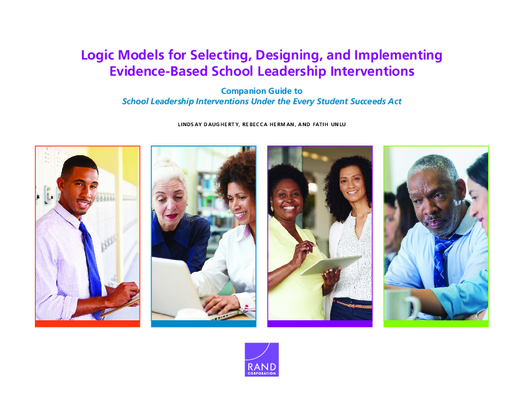
Breadcrumb
- Wallace
- Reports
- Logic Models For Selecting, Desi...
Logic Models for Selecting, Designing, and Implementing Evidence-Based School Leadership Interventions

- Author(s)
- Lindsay Daugherty, Rebecca Herman, and Fatih Unlu
- Publisher(s)
- RAND Corporation
- DOI Link
- https://doi.org/10.7249/TL274
Summary
How we did this
The authors used program documentation and research literature to develop logic models.
This guide walks grant applicants step-by-step to create “logic models” for school leadership activities that meet guidelines of the Every Student Succeeds Act (ESSA).
ESSA created new opportunities for federal funding to improve school leadership. However applicants for funding must often now present a logic model that shows how their proposed activities lead to desired outcomes. Logic models can also help educators define problems they want to tackle and think through the steps needed to solve them.
This guide is targeted at state and school district policymakers, among others. It’s a companion to a separate RAND publication about ESSA that explains federal requirements for funding school leadership activities.
This guide is organized into four sections:
- “Roadmap” to Logic Model Components. This is an overview of the logic model. It asks users to consider:
- The long-term goals they want to achieve
- The short-term results they expect to see
- The activities that will achieve the short-term results and long-term goals
- Whether they have sufficient resources to carry out those activities
- Understanding Different Leadership Intervention Types. This section describes six leadership interventions and the problems they address. The types of interventions are:
- Principal preparation programs
- Improving recruitment, selection, and assignment of principals to schools
- Professional learning for principals
- Improving principal evaluation
- Improving working conditions for principals
- School improvement models with a school leadership component
- The Link Between Leadership Interventions and Student Outcomes. This section provides detailed guidance for creating a logic model for each leadership intervention listed above.
- Considering Resources. This section leads users through a series of questions to help them determine whether they have the resources needed for their school leadership intervention.
Materials & Downloads
Key Takeways
- The Every Student Succeeds Act creates new opportunities for funding school leadership opportunities, but the law is complicated.
- Many opportunities for funding require a “logic model” to explain how proposed activities lead to certain outcomes.
- This guide provides step-by-step instructions for creating a logic model that meets the requirements of the Every Student Succeeds Act.



